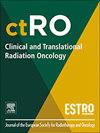基于18F-FET-PET和mri的靶标定义在复发性弥漫性胶质瘤再照射治疗中的比较
IF 2.7
3区 医学
Q3 ONCOLOGY
引用次数: 0
摘要
背景与目的复发性胶质瘤再照射的靶区定义通常依赖于t1加权钆增强MRI (T1Gd),但T1Gd无法捕获胶质瘤浸润。虽然T2 FLAIR和CTV切缘可以解决这一限制,但它们在再照射中的延伸范围仍存在争议,以尽量减少毒性。相比之下,18F-FET-PET成像可以更好地显示浸润成分,提高目标清晰度。本研究通过分析形状差异和灰质组织组成来探讨18F-FET-PET在目标定义中的作用。材料与方法回顾性分析36例复发性胶质瘤患者的资料。这些患者分别接受了18F-FET-PET和T1Gd检查,分别对生物肿瘤体积(BTVPET)和临床肿瘤体积(CTVMRI)进行了描绘。比较两组病灶体积、形状(Hausdorff distance, HD)、质心距离(CoM-D)、组织组成及再发体积。结果btvpet和非重叠BTVPET-GTVMRI的体积明显大于GTVMRI和非重叠gtvpet - btvpet (P <;0.001),但显著小于CTVMRI (P <;0.001)。中位HD和CoM-D分别为19 mm和6 mm。GTVMRI的白质(WM)比与无重叠BTVPET的WM有相关性(斜率= 0.36,R2 = 0.36;P <;0.001)和非重叠BTVPET与灰质(GM)的相关性(斜率= -0.15,R2 = 0.11;P <;0.05)。再照射后BTVPET复发率明显高于GTVMRI (P <;0.001)。GTVMRI复发率明显高于无重叠BTVPET (P <;0.001)。我们的研究结果表明,18F-FET-PET显示了更完整的胶质瘤浸润程度,建议重新考虑目前在T1Gd-GTV周围使用各向同性CTV边缘的方法,而采用基于18F-FET-PET的各向异性CTV。本文章由计算机程序翻译,如有差异,请以英文原文为准。
Comparison of 18F-FET-PET- and MRI-based target definition for re-irradiation treatment of recurrent diffuse glioma
Background and purpose
The target area definition for re-irradiation of recurrent glioma typically relies on T1-weighted gadolinium-enhanced MRI (T1Gd), but T1Gd fails to capture glioma infiltration. While T2 FLAIR and CTV margins can address this limitation, their extend in re-irradiation remains debated to minimize toxicity. In contrast, 18F-FET-PET imaging can better visualize infiltrative components, improving target definition. This study investigates the role of 18F-FET-PET in target definition by analyzing shape differences and gray-white matter tissue composition.
Material and methods
Retrospective data from 36 patients with recurrent glioma were used. These patients underwent 18F-FET-PET, on which Biological Tumor Volume (BTVPET) was delineated, and T1Gd, on which Gross Tumor Volume (GTVMRI) and Clinical tumor volume (CTVMRI) were delineated. Lesion volume, shape (Hausdorff distance (HD) and Center of Mass Distance (CoM-D)), tissue composition and re-recurrence volume were compared between the delineations.
Results
BTVPET and the non-overlapping BTVPET-GTVMRI volumes were significantly larger than GTVMRI and non-overlapping GTVMRI-BTVPET (P < 0.001), but significantly smaller than the CTVMRI (P < 0.001). The median HD and CoM-D were 19 mm and 6 mm. A correlation was found between the white matter (WM) ratio in GTVMRI and WM in non-overlapping BTVPET (slope = 0.36, R2 = 0.36;P < 0.001) and a correlation with gray matter (GM) in non-overlapping BTVPET (slope = -0.15, R2 = 0.11;P < 0.05). Recurrence after reirradiation was significantly higher within BTVPET than GTVMRI (P < 0.001). The ratio of the GTVMRI which recurred was significantly higher than the non-overlapping BTVPET (P < 0.001).
Conclusion
Our results suggest that 18F-FET-PET reveals a more complete extent of glioma’s infiltration, suggesting that the current practice of using isotropic CTV margins around the T1Gd-GTV should be reconsidered in favor of anisotropic CTV based on 18F-FET-PET.
求助全文
通过发布文献求助,成功后即可免费获取论文全文。
去求助
来源期刊

Clinical and Translational Radiation Oncology
Medicine-Radiology, Nuclear Medicine and Imaging
CiteScore
5.30
自引率
3.20%
发文量
114
审稿时长
40 days
 求助内容:
求助内容: 应助结果提醒方式:
应助结果提醒方式:


